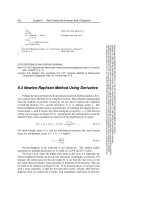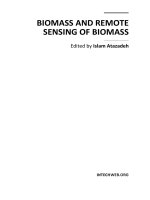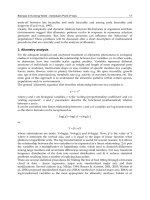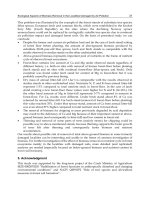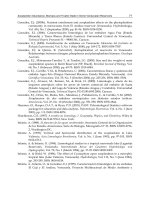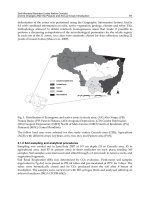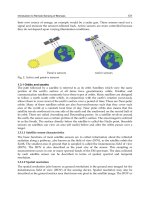Biomass and Remote Sensing of Biomass Part 5 pot
Bạn đang xem bản rút gọn của tài liệu. Xem và tải ngay bản đầy đủ của tài liệu tại đây (273.1 KB, 20 trang )
Zooplankton Abundance, Biomass and Trophic State in Some Venezuelan Reservoirs
71
González, E.J. (2000b). Nutrient enrichment and zooplankton effects on the phytoplankton
community in microcosms from El Andino reservoir (Venezuela). Hydrobiologia,
Vol. 434, No. 1 (September 2000), pp. 81-96. ISSN 0018-8158.
González, E.J. (2006). Caracterización limnológica de los embalses Agua Fría (Estado
Miranda) y Tierra Blanca (Estado Guárico). Universidad Central de Venezuela,
Technical Report, Proyecto S1 – 98001361, Caracas.
González, E.J. (2008). Eutrofización de embalses en Venezuela. Memorias del Instituto de
Biología Experimental, Vol. 5, No. 1 (May 2008), pp. 169-172. ISSN 0034-7507.
González, E.J. & Quirós, R. (Submitted). Eutrophication of reservoirs in Venezuela:
Relationships between nitrogen, phosphorus and phytoplankton biomass. Oecologia
Australis.
González, E.J., Matsumura-Tundisi, T., & Tundisi, J.G. (2008). Size and dry weight of main
zooplankton species in Bariri Reservoir (SP, Brazil). Brazilian Journal of Biology, Vol.
68, No. 1 (February 2008), pp. 69-75. ISSN 1519-6984.
González, E.J., Carrillo, V.M., & Peñaherrera, C. (2004). Características físicas y químicas del
embalse Agua Fría (Parque Nacional Macarao, Estado Miranda, Venezuela). Acta
Científica Venezolana, Vol. 55, No. 3 (October 2004), pp. 225-236. ISSN 0001-5504.
González, E.J., Álvarez, M., Barrero, M., & Finol, H. (2009). Limnología y efecto de los
impactos antrópicos sobre los peces de interés comercial del embalse de Suata
(Estado Aragua) y del Lago de Valencia (Estados Aragua y Carabobo). Universidad
Central de Venezuela, Technical Report, PG 03.00.6495.2006, Caracas.
González, E.J., Ortaz, M., Matos, M.L., Mendoza, J., Peñaherrera, C., & Carrillo, V.M. (2002).
Zooplancton de dos embalses neotropicales con distintos estados tróficos.
Interciencia, Vol. 27, No. 10 (October 2002), pp. 551-558. ISSN 0378-1844.
Hammer, Ø., Harper, D.A.T., & Ryan, P.D. (2001). PAST: Paleontological Statistics software
package for education and data analysis. Paleontologia Electronica, Vol. 4, No. 1 (June
2001), pp. 1-9. ISSN 1094-8074.
Hutchinson, G.E. (1957). A treatise on Limnology. 1. Geography, Physics, and Chemistry. Wiley &
Sons, ISBN 04-7142-570-2, New York.
Infante, A. (1988). El plancton de las aguas continentales. Secretaría General de la Organización
de los Estados Americanos, Serie de Biología, Monografía Nº 33, ISBN 0-8270-2736-
2, Washington DC.
Infante A. (1993). Vertical and horizontal distribution of the zooplankton in Lake
Valencia. Acta Limnologica Brasiliensia, Vol. 6, No. 1 (June 1993), pp. 97-105. ISSN
0102-6712.
Infante, A. & Infante, O. (1994). Limnological studies in a tropical man-made lake (Lagartijo
Reservoir), Venezuela. Internationale Revue der Gesamten Hydrobiologie und
Hydrographie, Vol. 79, No. 1 (March 1994), pp. 17-25. ISSN 0020-9309.
Infante, A. & Riehl, W. (1984). The effect of Cyanophyta upon zooplankton in a eutrophic
tropical lake (Lake Valencia, Venezuela). Hydrobiologia, Vol. 113, No. 1 (June 1984),
pp. 293-295. ISSN 0018-8158.
Infante, A., Infante, O., & González, E.J. (1995). Caracterización limnológica de los embalses
El Cují y El Andino, Venezuela. Proyecto Multinacional de Medio Ambiente y
Biomass and Remote Sensing of Biomass
72
Recursos Naturales. Technical Report. Organización de los Estados Americanos,
Universidad Central de Venezuela, Caracas.
Infante, A., Infante, O., & Vegas, T. (1992). Caracterización limnológica de los embalses
Camatagua, Guanapito y Lagartijo, Venezuela. Proyecto Multinacional de Medio
Ambiente y Recursos Naturales. Technical Report. Organización de los Estados
Americanos, Universidad Central de Venezuela, Caracas.
Lampert, W. & Sommer, U. (1997). Limnoecology. The ecology of lakes and streams. Oxford
University Press, ISBN 0-19-509592-8, Oxford.
Landa, G.G., Barbosa, F.A.R., Rietzler, A.C., & Maia-Barbosa, P.M. (2007). Thermocyclops
decipiens (Kiefer, 1929) (Copepoda, Cyclopoida) as indicator of water quality in the
State of Minas Gerais, Brazil. Brazilian Archives of Biology and Technology, Vol. 50,
No. 4 (July 2007), pp. 695-705. ISSN 1516-8913.
Leitão, A.C., Freire, R.H., Rocha, O., & Santaella, S.T. (2004). Zooplankton community
composition and abundance of two Brazilian semiarid reservoirs. Acta Limnologica
Brasiliensia, Vol. 18, No. 4 (October 2006), pp. 451-468. ISSN 0102-6712.
Lewis, W.M. (1983). A revised classification of lakes based on mixing. Canadian Journal of
Fisheries and Aquatic Sciences, Vol. 40, No. 10 (October 1983), pp. 1779–1787. ISSN
1205-7533.
López, C., Villalobos, M., & González, E.J. (2001). Estudio sobre el zooplancton de los
embalses de Venezuela: Estado actual y recomendaciones para futuras
investigaciones. Ciencia, Vol. 9, No. 2 (April 2001), pp. 217-234. ISSN 1315-2076.
Matsumura-Tundisi, T. (1997). Composition and vertical distribution of zooplankton in Lake
Dom Helvécio - MG, Brazil, In: Limnological studies on the Rio Doce valley lakes, Brazil,
J.G. Tundisi & Y. Saijo (Eds.), pp. 309-326, Brazilian Academy of Sciences,
University of São Paulo, ISBN 85-85761-07-5, Rio de Janeiro.
Matsumura-Tundisi, T., Rietzler, A., & Tundisi, J.G. 1989. Biomass (dry weight and carbon
content) of plankton crustacea from Broa reservoir (São Carlos, S.P. – Brazil) and its
fluctuation across one year. Hydrobiologia, Vol. 179, No. 3 (July 1989), pp. 229-236.
ISSN 0018-8158.
McQueen, D.J., Post, J.R., & Mills, E.L. (1986). Trophic relationships in freshwater pelagic
ecosystems. Canadian Journal of Fisheries and Aquatic Sciences, Vol. 43, No. 8 (August
1986), pp. 1571-1581. ISSN 1205-7533.
Melão, M.G.G. & Rocha, O. (2004). Life history, biomass and production of two planktonic
cyclopoid copepods in a shallow subtropical reservoir. Journal of Plankton Research,
Vol. 26, No. 8 (April 2004), pp. 909-923. ISSN 0142-7873.
Mélo-Júnior, M., Santos-Almeida, V.L., Nogueira-Paranaguá, M., & Nascimento-Moura, A.
(2007). Crustâceos planctônicos de um reservatório oligotrófico do Nordeste do
Brasil. Revista Brasileira de Zoociências, Vol. 9, No. 1 (June 2007), pp. 19-30. ISSN
1517-6770.
Mendoza, J. (1999). Variaciones de abundancia del plancton y de las bacterias en el embalse
La Mariposa (Dtto. Federal, Venezuela): Período noviembre 1998 - mayo 1999.
Universidad Central de Venezuela, Thesis, Caracas.
Zooplankton Abundance, Biomass and Trophic State in Some Venezuelan Reservoirs
73
Merayo, S. & González, E.J. (2010). Variaciones de abundancia y biomasa del zooplancton en
un embalse tropical oligo-mesotrófico del norte de Venezuela. Revista de Biología
Tropical, Vol. 58, No. 2 (June 2010), pp. 603-619. ISSN 0034-7744.
Ministerio del Ambiente (MINAMB). (2007). Rehabilitación de presas a nivel nacional.
Organización para la rehabilitación y mantenimiento de embalses. Ministerio del
Poder Popular para el Ambiente (MINAMB). Technical Report. Serie de Informes
Técnicos, DGEA/IT/864. No. X-002/P-129/02 Rev. B. Caracas.
Mustapha, M.K. (2009). Zooplankton assembalge of Oyun reservoir, Offa, Nigeria. Revista de
Biología Tropical, Vol. 57, No. 4 (December 2009), pp. 1027-1047. ISSN 0034-7744.
Nusch, E.A. & Palme, G. (1975). Biologische Methoden für der Praxis der
Gewässeruntersuchung, Bestimmung des Chlorophyll-a und Phaeopigment-gehaltes
in Oberflachenwäser. GWF-Wasser/Abwässer, Vol. 116, No. 2 (May 1975), pp. 562-565.
ISSN 6601-8628.
Ortaz, M., González, E.J., Manduca, J., Peñaherrera, C., & Montes, E. (1999). Características
limnológicas de los embalses La Pereza, Lagartijo, La Mariposa y Quebrada Seca y
preservación del zooplancton como controlador de microalgas, mediante técnicas
de biomanipulación. Hidroimpacto C.A., Hidrocapital, Universidad Central de
Venezuela, Technical Report, Caracas.
Pinto-Coelho, R.M., Bezerra-Neto, J.F., & Morais-Jr., C.A. (2005). Effects of eutrophication on
size and biomass of crustacean zooplankton in a tropical reservoir. Brazilian Journal
of Biology, Vol. 65, No. 2 (May 2005), pp. 325-338. ISSN 1519-6984.
Rocha, O., Sendacz, S., & Matsumura-Tundisi, T. (1995). Composition, biomass and
productivity of zooplankton in natural lakes and reservoirs of Brazil, In: Limnology
in Brazil. J.G. Tundsi, C.E.M. Bicudo, & T. Matsumura-Tundisi (Eds.), pp. 151-165,
Brazilian Academy of Sciences, Brazilian Limnological Society, ISBN 85-7093-003-8,
Rio de Janeiro.
Rocha, O., Matsumura-Tundisi, T., Espíndola, E.L.G., Roche, K.F., & Rietzler, A.C. (1999).
Ecological theory applied to reservoir zooplankton, In: Theoretical reservoir ecology
and its applications. J.G. Tundisi & M. Straškraba (Eds.), pp. 457-476, Brazilian
Academy of Sciences, International Institute of Ecology, Backhuys Publishers, ISBN
90-5782-034-X, São Carlos.
Salas, H. & Martinó, P. (1991). A simplified phosphorus trophic state model for warm-water
tropical lakes. Water Research, Vol. 25, No. 3 (March 1991), pp. 341-350. ISSN 0043-
1354.
Santos-Wisniewski, M.J. & Rocha, O. (2007). Spatial distribution and secondary production
of Copepoda in a tropical reservoir: Barra Bonita, SP, Brazil. Brazilian Journal of
Biology, Vol. 67, No. 2 (May 2007), pp.223-233. ISSN 1519-6984.
Sendacz, S., Caleffi, S., & Santos-Soares, J. (2006). Zooplankton biomass of reservoirs in
different trophic conditions in the state of São Paulo, Brazil. Brazilian Journal of
Biology, Vol. 66, No. 1b (February 2006), pp. 337-350. ISSN 1519-6984.
Tundisi, J.G., Matsumura-Tundisi, T., & Abe, D.S. (2008). The ecological dynamics of Barra
Bonita (Tietê River, SP, Brazil) reservoir: Implications for its biodiversity. Brazilian
Journal of Biology, Vol. 68, No. 4 (Supp.) (November 2008), pp. 1079-1098. ISSN 1519-
6984.
Biomass and Remote Sensing of Biomass
74
Wetzel, R. & Likens, G.E. (2000). Limnologycal analyses (3
rd
edition), Springer, ISBN 0-387-
98928-5, New York.
Zhao, J., Ramin, M., Cheng, V., & Arhonditsis, G.B. (2008). Plankton community patterns
across a trophic gradient: The role of zooplankton functional groups. Ecological
Modelling, Vol. 213, No. 3-4 (May 2008), pp. 417-436. ISSN 0304-3800.
5
Estimation of Above-Ground
Biomass of Wetlands
Laimdota Truus
Institute of Ecology at Tallinn University
Estonia
1. Introduction
Despite global importance of wetlands, estimations of their production and biomass have
received little attention (Campbell et al., 2000). This chapter concentrates on analysis of the
composition and above-ground biomass of floodplain grasslands and fen vegetation in the
Northern forest zone. Both vegetation types were extensively used for hay and/or grazing
up to the middle of the 20th century, and abandoned later.
Systematic biomass estimations were conducted in the 1970s–1980s (Estonian data from
1977–1980; most data from Canada from 1972–1978 (Campbell et al., 2000)) when they were
feasible for agricultural use. Papers on vegetation production and above-ground biomass of
wetlands are quite scarce nowadays. Biomass has sometimes been measured for developing
community structure theories, e.g. Zobel & Liira (1997) included some wet grasslands into
analysis of richness vs biomass relationship. Still, some thorough reviews can be found like
an overview of biomass of rich fen types in South England and Wales by Wheeler & Shaw
(1991). New interest in the subject has risen in the context of biomass use for bioenergy
production (e.g. Rösch et al., 2009).
Many plant species cannot survive without special accommodation to wetland conditions.
The composition of wetland vegetation is mostly controlled by the wetland water level (WL)
(Bootsma & Wassen, 1996; Hájková et al., 2004; Barry et al., 2008). Wilcox & Nichols (2008)
and Ilomets et al. (2010) found that the diversity and habitat value of plant communities
depend on the wetland WL and the water level amplitude between dry and wet seasons
(WLA). In fens with a constantly high WL rhizome-spreading graminoids and herbs
dominate, while drainage and fluctuating WL support high tussock-forming graminoids.
A specific feature of both floodplain grassland and fen vegetation is high patchiness due to
variations in WL and WLA caused by microtopography (Liira et al., 2009). Tussocks, formed
by herbaceous plants or tree stumps, locally increase the habitat variability even more (Liira
et al., 2009; Ilomets et al., 2010).
Total biomass of wetland vegetation is significantly affected by three main factors: the N:P
ratio, total nutrient supply and morphological and physiological traits of plants (Güsewell,
2005). Biomass variations are higher on moister sites such as wet floodplain grasslands (Truus
& Puusild, 2009) and fens (Ilomets et al., 2010). The height and coverage of tussocks increases
with denser or deeper drainage. About 52% of the vascular plant species variance occurs due
to four environmental variables: amplitude of WL (between spring flooding and midsummer
dry period), midsummer WL, mire water pH and electrical conductivity (Ilomets et al., 2010).
Biomass and Remote Sensing of Biomass
76
Truus & Puusild (2009) found strong relation of the above-ground biomass with the
management regime but not with the variations in site conditions on wet and moist
floodplain grasslands. Wilson & Keddy (1986), Moore & Keddy (1989) and Garica et al.
(1993) detected general hump-back relationship between species richness and biomass, but
it has also been shown that a high number of factors can complicate prediction of species
richness from community biomass (Gough et al., 1994).
2. Factors affecting wetland productivity and species richness
2.1 Relationship between species richness and biomass
The relation between plant species richness and biomass was first discussed by Grime (1973,
1979) and Al-Mufti et al. (1977) when describing general hump-back relationship between
species density and community biomass. According to these authors, maximum species
richness can be found at medium values of biomass. Later, this relation has been approved
(Wheeler & Giller, 1982) or denied (Gough et al., 1994). In the development of this theory
Zobel & Liira (1997) attributed species richness to the plant ramet density.
Gough et al. (1994) established correlation between environmental conditions and species
richness but not between biomass and environmental conditions. Therefore, the influence of
environmental conditions on species richness could not be assumed strictly from biomass.
Wheeler & Giller (1982), Boyer & Wheeler (1989) and Wheeler & Shaw (1991) recorded
differences in biomass– species richness relation between community types (low-sedge low-
productive fen, productive tall-sedge and reed fen, and fertile site communities with strong
domination of Filipendula ulmaria or Molinia cerulea).
According to Gough et al. (1994), two types of processes operate in the species richness–
productivity relation on wetlands:
At low levels of productivity, species richness is primarily limited by the ability of the
species to survive the abiotic conditions. In this range increase in productivity reflects a
decrease in the harshness of the environment.
At higher levels of community productivity, the decline in richness is believed to be
related in some way to a greater degree of competitive exclusion with increasing
productivity. For wetlands this relation was revealed by Wheeler & Giller (1982).
Examining herbaceous fen vegetation, they found that species richness was negatively
correlated to above-ground biomass.
Wet meadows are poorer in species than those on mineral soil. Two reasons could be
pointed out:
Hard environmental stress that excludes several plant species.
The absence of management leading to domination of tall plants and accumulation of
dead biomass on soil surface (Truus, 1998).
Strong correlation has been found in fens between the height and coverage of the tussock-
forming graminoid Molinia cerulea in fens with fluctuating WL and midsummer WL
minimum (Ilomets et al., 2010).
In general, relationship of species richness and above-ground biomass is complex and
hardly predictable, especially for wetlands.
2.2 Limitations of productivity
2.2.1 Flood, water level and water level amplitude
On floodplain meadows the duration and intensivity of flooding serve as environmental
determinants of plant species selection. Riverine floodwater pulses provide water, nutrient-
Estimation of Above-Ground Biomass of Wetlands
77
rich material and sediments to floodplain wetlands, but flood pulses also act as a natural
disturbance by removing biomass, scouring sediments and delivering turbid waters (Bayley
& Guimond, 2009). Riparian ecosystems are among the most diverse systems on the world’s
continents (Nilsson et al., 1997). The intensity of natural processes taking place on
floodplains is variable, depending on the properties of the river and shore. Estonian rivers
are usually small and floodplains narrow. Thereby most riverborn nutrients settle on the 50
m wide belt close to the river channel
1
where productive high-growing vegetation develops.
An exception is South Estonia where luxorious sandy sediments form rapidly desiccating
low-productivity dry floodplain meadows.
The species composition of spring fen communities is mainly influenced by groundwater
chemistry, especially pH, electrical conductivity and mineral richness (Hájek et al., 2002). It
is unknown whether these factors affect species richness and the amount of above-ground
biomass (Hájkova & Hájek, 2003).
2.2.2 Water and soil chemistry and nutrient availability
Water and soil chemistry and nutrient availability to plants are among the important factors
controlling the diversity of wetland vegetation.
Floods bring extra nutrients to floodplain grasslands. Thus there is no N and P deficit and
vegetation is luxorious. Management of grasslands removes nutrients from soil and biomass
production decreases. Without management, however, annual biomass production increases.
Fens are characterized by high concentrations of cations in soil and water. The concentration
of Ca, Fe, N, P and K in plants varies along the poor–rich fen vegetation gradient from poor
Sphagnum-fens to calcareous fens, and from sedge-moss fens to forb-rich wet meadows
(Rozbrojová & Hájek, 2008). The same study showed that the fertility gradient was largely
independent of the poor–rich (pH/calcium) gradient. Nutrient limitations of fens are
complicated: species in one community can have different limitations (Rozbrojová & Hájek,
2008). Low-productivity fen communities that support more rare species (Wassen et al.,
2005) are rather P- or K- (co)limited, or limited by different environmental conditions
(Rozbrojová & Hájek, 2008).
2.2.3 Management
Due to nutrient supply by floodwater, the soil of floodplain meadows is rich in nutrients
and biomass productivity is high. The amounts of nutrients brought by floods is comparable
to quantities taken away with the harvest or/and cattle grazing. Clipping increase species
richness and shoot density but decrease above-ground biomass, thus creating more
favourable conditions for more plant species. Bakker (2007) demonstrated that cutting
reduces the vigour of tall competitive species, allowing smaller species coexist. Nowadays
most of the floodplain meadows are left unmanaged. Hay is mown only in restricted areas
for the purposes of environmental protection.
In comparison with other meadow types above-ground biomass production is lower on dry
floodplain meadows and higher on floodplain marshes. Productivity is variable in all
floodplain meadow community types depending on species composition (Table 1). On wet
meadows the site moisture conditions are greatly responsible for plant ecological traits. On
1
Pork, K. (1984). Jõeluhtade looduslikus seisundis säilitamisest. In: Looduskaitse ja põllumajandus.
Kumari, E., Randalu, I. & Hang, V. (Eds.). Academy of Sciences of the E.S.S.R, 58–70. [In Estonian]
Biomass and Remote Sensing of Biomass
78
permanently wet sites both tussock-forming and mat-forming graminoids dominate while
herbs dominate where soil WL drops down at least in summer (Fig. 1). Comparison of
Estonian data from the period of regular management (Table 1) with the period of
abandonment (Tables 2 and 3) showed that productivity had risen due to accumulation of
plant nutrients on unmanaged meadow soils. Above-ground biomass varied threefold,
depending on the management regime (Table 3). Liira et al. (2009) also noticed that
management lowered canopy height but revealed differences in functional trait structure in
more detail.
Falinska (1991, 1995) described two stages in the after-abandonment vegetation succession
in Cirsium rivularis phytocoenosis on wet grassland. The initial stage of the succession lasted
about 9 years: half of 142 plant species retreated but 12 species became dominant and a
macroforb meadow community (Lysimachio vulgaris–Filipenduletum) meadow with mosaic
structure, including species like Filipendula ulmaria, Carex cespitosa, C. acutiformis, Lythrum
salicaria and Lysimachia vulgaris, was formed. During the following 15 years a specific spatial
complex developed, consisting of meadow and herbaceous communities and willow shrub
aggregations with the first tree species. Next the Circaeo-Alnetum woodland community
appeared. The succession exhibits differentiation of the horizontal structure – increase in
patchiness, and differentiation of the vertical structure – plant height started to increase
immediately after management stopped and most of the above-ground biomass moved
higher from the near-surface position.
Fig. 1. Life-form distribution on Soomaa (West Estonia) wet and moist floodplain meadows
The species composition and duration of this vegetation change depend on climatic and
trophic conditions and hydrology, also on the ecological trait of plants and availability of
diaspores. General trends, however, are: decrease in species richness, change in species
composition, increase in vegetation height and above-ground biomass, and finally
replacement of the herbaceous community by woodland. Re-location of most of the biomass
to a higher level in the community as described by Falinska (1991, 1995) takes place if herbs
dominate – on wet meadows at a drier site. No comparable data about composition and
biomass change are available due to abandonment of seminatural hay lands and pastures.
Just general trends in vegetation change can be followed.
Estimation of Above-Ground Biomass of Wetlands
79
Floodplain meadow
type
2
English description of
classification in Truus &
Tõnisson, 1998
Plant community Above-ground
biomass
(g m
-2
)
Above-ground
biomass, mean
for community
type
(g m
-2
)
Dry floodplain meadow Sesleria–Festucetum ovinaea 150
80
Seslerio–Nardetum 40
Thymo–Festucetum 30–100
Sieglingo–Nardetum 40–80
Anthoxantho–Agrostetum 40–100
Galio–Agrostetum tenuis 50–150
Moderately moist
floodplain meadow
Agrostetum giganteae
150–250
200
Deschampsio–Festucetum
rubrae
100–300
Alopecuretum pratensis
150–380
Moist floodplain meadow
Cirsio–Polygonetum bistortae 150–300
230
Filipendulo–Geranietum
palustris
200–400
Deschampsieto–Caricetum
caespitosae
100–250
Elytrigieto–Alopecuretum
arundinacei
150–300
Wet floodplain meadow
with tall grasses
Stellario-Deschampsietum
80–200 (300)
250
Phalaroidetum
150–500
Wet floodplain meadow
with tall sedges
Caricetum distichae
200–250 260
Caricetum acutae
100–450
Caricetum rostrato-vesicariae
100–450
Floodplain marshes
Seslerio-Caricetum paniceae
40–100
125
Caricetum paniceo-nigrae
50–150
Caricetum diandro-nigrae
50–180
Caricetum cespitoso-
appropinquatae
100–200
Caricetum elatae
80–300
Table 1. Mean above-ground biomass of plant communities of floodplain meadows. The
analyses are means for Estonia representing seminatural hay meadows in 1978-1981
2
Analysis of life-form distribution on Estonian floodplain meadows in periods with different
management showed an increased proportion of tall herbs and graminoids instead of low
herbs and graminoids in the 1960s when these areas were mostly regularly mown and the
end of the 1990s when they were out of use (Fig. 2). The proportion of tall tussock-forming
graminoids did not change. On floodplain grasslands these plants inhabit depressions with
a higher water table and thereby were absent even in the former period.
2
Krall, H., Pork, K., Aug, H., Püss, O., Rooma, I. & Teras, T. (1980). Eesti NSV looduslike rohumaade tüübid
ja tähtsamad taimekooslused, ENSV Põllumajandusministeerium IJV, Tallinn. [In Estonian]
Biomass and Remote Sensing of Biomass
80
3. Above-ground biomass
3.1 Methods for standing crop estimation
Wheeler & Shaw (1991) calculated above-ground biomass as the biomass increment between
April and September. In regions with a dormant season for herbaceous plants in winter,
above-ground biomass (that also represents production per year) is in its maximum in the
middle of summer, but before abundant flowering. In wetlands different flowering times
can be noticed: the sedges usually stop growing and flower in May and June (Leht, 1999)
while common reed continues growing up to the August. In all cases, biomass samples were
air-dried before measuring. Standing biomass measured in its maximum is usually
equalized with production.
3.2 Above-ground biomass of floodplain meadows
In the period of regular management, mean values for above-ground biomass of Estonian
floodplain meadows measured from 80 to 260 g m
-2
, varying largely between community
types and even communities
2
. On unmanaged floodplain meadows those values are more
than twice higher (Tables 2 and 3). Zobel & Liira (1997) presented biomass values from 300
to 600 g m
-2
for West Estonian floodplain meadows of Sauga, Vaskjõe and Kasari (the lowest
value on a dry site). High standard deviation in Tables 2 and 3 shows high variability of
floodplain meadows vegetation discussed earlier. For comparison, in the Czech Republic
Molinio-Arrhenetheretea above-ground biomass in a moist floodplain meadow was 300–350 g
m
-2
(Joyce, 2001). Values of above-ground biomass from the earlier (with regular hay
cutting; Table 1) and later (without management; Tables 2 and 3) periods show an increase
in standing crop that can be explained as a result of management cessation. Standing
biomass also varied threefold (from 263 to 763 g m
-2
) on floodplains in Soomaa, West
Estonia (Truus & Puusild, 2009).
Floodplain meadow type
English description in Truus & Tõnisson, 1998
Above-ground biomass
(g m
-2
,
St.Dev in parentheses)
Dry 458 (148.6)
Moderately moist 493 (240)
Moist 350 (448.3)
Wet (no data)
Wet with tall sedges 742 (70.3)
Floodplain marsh 376 (100.9)
Table 2. Mean above-ground biomass on the Kloostri landscape transect, West Estonia.
Previous hay-meadow, abandoned over 15 years
Truus & Puusild (2009) studied the distribution of ecological groups (graminoids, herbs, low
and tall growth-form) in relation to management cessation. The ecological group
composition turned towards tussock-forming plants but the most obvious change was the
increase in vegetation height (Fig. 2).
Unmanaged wetlands are dominated by powerful species (Wheeler & Giller, 1982; Truus,
1998; Truus & Puusild, 2009). On sites with a permanently high groundwater level
Deschampsia cespitosa or Carex cespitosa form high tussocks while low-growing tussocks
(Nardus stricta, Festuca ovina) spread on dry or moist managed grasslands. The abandonment
Estimation of Above-Ground Biomass of Wetlands
81
Floodplain meadow type
English description in Truus & Tõnisson, 1998
Above-ground biomass
(g m
-2
,
St.Dev in parentheses)
Moist, regularly mown 572 (692.3)
Moist, mown, recently abandoned 333 (167.5)
Moist, unmown but mowing reintroduced 380 (178.2)
Moist, unmown over 15 years 763 (627.5)
Wet, regularly mown 263 (108.0)
Wet, mown, recently abandoned 516 (165.9)
Wet, unmown, but mowing reintroduced 452 (398.7)
Wet, unmown over 15 years 447 (86.4)
Table 3. Mean above-ground biomass on moist and wet floodplain meadows with different
management regimes in Soomaa, West Estonia.
Fig. 2. Proportions of the most frequent growth-forms on floodplain meadows in periods of
extensive management (first half of the 20th century) and unmanagement (end of the 1990s)
of grasslands can lead to dominance (in some cases to almost monospecies communities) of
tall herbs like Filipendula ulmaria. The coverage and height of tussocks of Molinia cerulea
increase on rich fen meadows (Ilomets et al., 2010).
3.3 Biomass of fens
Fen vegetation presented in Table 4 is highly variable and the biomass values vary between
locations. The above-ground biomass values for low-growing vegetation range from 50 to
500 g m
-2
and from 600 to 1750 g m
–2
for both tall graminoids and tall herbs. For comparison,
in Canada and adjacent USA mean above-ground biomass was 337 ± 142 g m
-2
for fens and
bogs, and 924 ± 463 g m
-2
for marshes and swamps (Campbell et al., 2000).
No recent data are available on biomass production on fens in Estonia. The data from 1977–
1980 (Table 4) gives very low values (50 g m
-2
) for above-ground biomass of fen meadows.
Biomass and Remote Sensing of Biomass
82
The utilization of fen meadows grew in Estonia at the beginning of the 20th century. An
experiment from 1922–1926 showed the yield of 140 to 450 g m
-2
from unfertilized fen
meadows.
3
. It was also mentioned that during the experiment hay production was related to
weather conditions but decreased year by year (probably because of experimental hay cutting).
Location Vegetation community Dry
standing
biomass
(g m
-2
)
St.Dev. in
parentheses
Reference
England and Wales Schoeno–Juncetum ~ 200
Wheeler & Shaw,
1991, Fig. 1
England and Wales Acrocladio–Caricetum ~ 200
England and Wales Potentillo–Caricetum ~ 200
England and Wales Peucedano–Phragmitetum ~ 300
England and Wales Rich-fen meadow ~ 500
England and Wales Cladio–Molinietum ~ 600
England and Wales Peucedano–Phragmitetum ~ 700
England and Wales Angelico–Phragmitetum ~ 850
England and Wales Cicuto–Phragmitetum ~ 1200
England and Wales Phragmites consociation ~ 1300
England and Wales
Glyceria maxima
community
~ 1500
England and Wales Tall herb fen ~ 1750
England and Wales
Phalaris arundinacea
community
900–1200 Smith et al., 1985
England and Wales
Glyceria maxima
community
700–1200
Siberia, Russia Carex–dominating fen 200 Pjavtšenko, 1967
Switzerland Saxifraga hirculus fen 152–231 Venterink &
Vittouz, 2008
Netherlands Molinietalia fen ~ 300–400 Van der Hoek &
Sýkora, 2006
Estonia Drepanoclado–Schoenetum 50 Data from 1977-
1980
2
Estonia
Seslerio–Caricetum paniceae
50
Table 4. Above-ground biomass of fens with highly variable composition in different regions
3
Rinne, L. (1927). Sooheinamaa toodangu kahanemisest väetuse puudusel. Eesti Sooparanduse Seltsi
teated, Vol.8&9, 3–15. [In Estonian]
Estimation of Above-Ground Biomass of Wetlands
83
4. Conclusions
Vegetation of floodplain meadows and fens varies depending on the environmental (soil,
water) conditions and management regime. Both vegetation types have been in economic
use but a great part of them is in the successional stage due to abandonment.
On low-productive sites plant species richness is primarily limited on abiotic conditions
(WL, WLA, mineral content of soil and water, availability of plant nutrients).
The main limitation in highly productive sites is competition for light. Tall graminoids or
herbs compete out low-growing plants, enabling even the development of monospecies
vegetation.
The management status determines plant species richness and the above-ground biomass
production. Above-ground standing biomass varied threefold due to management cessation
on West Estonian floodplain grassland. Widespread cessation of management on
seminatural meadows is a key for interpretation of different above-ground biomass values
from different periods. Fen vegetation is probably more sensitive to above-ground biomass
cutting than floodplain grassland vegetation.
It is complicated to predict species richness from community biomass, and biomass (or
production) from site conditions.
Values of above-ground biomass increase from north to south but the geographical
latitude (availability of photosynthetic radiation) is not as strong determinant for biomass
production of wet grasslands as the local hydrological, nutritional and management
status.
5. Acknowledgement
This research was financed by the Estonian Ministry of Education and Research (targeted
funding project No. 0280009s07). The author is indebted to Anne Noor for linguistic help.
6. References
Al-Mufti, M.M., Sydes, C.L., Furness, S.B., Grime, J.P. & Band, S.R. (1977). A quantitative
analysis of shoot phenology and dominance in herbaceous vegetation. J. Ecol.,
Vol.65, 759–791, ISSN 10.2307/i313577
Barry, M.J., Andreas, B.K. & De Szalay, F.A. (2008). Long-term plant community changes in
managed fens in Ohio, USA. Aquat. Conserv., Vol.18, 392–407, ISSN 1099-0755
Bayley, S. E. & Guimond, J.K. (2009). Aboveground biomass and nutrient limitation in
relation to river connectivity in montane floodplain marshes. Wetlands, Vol.29,
No.4, 1243–1254, ISSN 0277-5212
Bootsma, M.C. & Wassen, M.J. (1996). Environmental conditions and fen vegetation in three
lowland mires. Vegetatio, Vol.127, 173–189, ISSN 1385-0237
Boyer, M.L.H. & Wheeler, B.D. (1989). Vegetation patterns in spring-fed calcareous fens:
calcite precipitation and constraints on fertility. J. Ecol., Vol.77, 597–609, ISSN
10.2307/i313577
Campbell, C., Vitt, D.H., Halsey, L.A., Campbell, I.D., Thormann, M.N. & Bayley, S.E.
(2000). Net primary production and standing biomass in northern continental wetlands.
Biomass and Remote Sensing of Biomass
84
Information report NOR-X-369. Canadian Forest Service, Northern Forestry Centre,
ISSN 0704-7673, Canada
Falinska, K. (1991). Plant demography and vegetation succession. Kluwer Academic Publishers,
ISBN 0-7923-1060-8, Dordrecht, Boston, London
Falinska, K. (1995). Genet disintegration in Filipendula ulmaria: consequences for population
dynamics and vegetation succession. J. Ecol. Vol.83, 9–21, ISSN 10.2307/i313577
Garcia, L.V., Maranon, T., Moreno, A. & Clemente, L. (1993). Above-ground biomass and
species richness in a Mediterranean salt marsh. J. Veg. Sci., Vol.4, 417–424, ISSN
1100-9233
Gough, L., Grace, J.B. & Taylor, K.L. (1994). The relationship between species richness and
community biomass: the importance of environmental variables. Oikos, Vol.70, 271–
279, ISSN 0030-1299
Grime, J.P. (1973). Competitive exclusion in herbaceous vegetation. Nature, Vol.242, 344–347,
ISSN 0028-0836
Grime, J.P. (1979). Plant strategies and vegetation processes. Wiley & Sons Ltd, ISBN 04719920,
Chichester, U.K.
Güsewell, S. (2005). Responses of wetland graminoids to the relative supply of nitrogen and
phosphorus. Plant Ecol., Vol.176, 35–55, ISSN 1385-0237
Hájek, M., Hekera, P. & Hájkova, P. (2002). Spring fen vegetation and water chemistry in the
West Carpathian flysh zone. Folia Geobot., Vol.37, 205–224, ISSN 1211-9520
Hájkova, P. & Hájek, M. (2003). Species richness and above-ground biomass of poor and
calcareous spring fens in the flysh Weat Carpathians, and their relationship to
water and soil chemistry. Preslia, Vol.75, 271–287, ISSN 0032-7786
Hájková, P., Wolf, P. & Hájek, M. (2004). Environmental factors and Carpathian spring fen
vegetation: the importance of scale and temporal variation, Ann. Bot. Fenn., Vol.41,
249–262, ISSN 0003-3847
Ilomets, M., Truus, L., Pajula, R. & Sepp, K. (2010). Species composition and structure of
vascular plants and bryophytes on the water level gradient within a calcareous fen
in North Estonia. Est. J. Ecol., Vol.59, No.1, 19–38, ISSN 1736-7549
Joyce, C. 2001. The sensitivity of a species-rich flood-meadow plant community to fertilizer
nitrogen: the Lužnice river floodplain, Czech Republic. Plant Ecol., Vol.155, 47–60,
ISSN 1385-0237
Leht, M. (Ed.). (1999). Eesti taimede määraja. EPMÜ ZBI, Eesti Loodusfoto, ISBN 9985-830-27-
X, Tartu, Estonia (In Estonian)
Liira, J., Issak, M., Jõgar, Ü., Mändoja, M. & Zobel, M. (2009). Restoration management of a
floodplain meadow and its cost-effectiveness – The results of a 6-year experiment.
Ann. Bot. Fen., Vol.46, 397–408, ISSN 0003-3847
Moore, D.R.J. & Keddy, P.A. (1989). The relationship between species richness and
standing crop in wetlands: The importance of scale. Vegetatio, Vol.79, 99–106,
ISSN 1406-0914
Moore, D.R.J., Keddy, P.A., Gaudet, C.L. & Wisheu, I. (1989). Conservation of wetlands: do
infertile wetlands deserve a higher priority? Biol. Conserv., Vol.47, 203–217, ISSN
0006-3207
Estimation of Above-Ground Biomass of Wetlands
85
Nilsson, C., Jansson R. & Zinko, U. (1997).Long-term responses of river-margin vegetation to
water-level regulation. Science, Vol.276, 798–800, ISSN 00368075
Pjavtšenko, N.I. (1967). O produktivnosti bolot Zapadnoi Sibiri. Rastitelnõje Resursõ. Vol.3,
No.4, 523–533, ISSN 0033-9946 (In Russian)
Rozbrojová, Z. & Hájek, M. (2008). Changes in nutrient limitation of spring fen vegetation
along environmental gradients in the West Carpathians. J. Veg. Sci., Vol.19, 613–620,
ISSN 1100-9233
Rösch, C., Skarka, J., Raab, K., Stelzer, V. (2009). Energy production from grassland –
Assessing the sustainability of different process chains under German conditions.
Biomass and Bioenergy, Vol.33, 689–700, ISSN 0961-9534
Smith, S.J., Ridge, I. & Morris, R.M. (1984). The biomass potential of seasonally flooded
wetlands. In: Proceedings of Bioenergy’ 84 World Conference, 15-21 June 1984 in
Goteborg, Sweden, The Bioenergy Council, 190–195, ISBN 9780853343516, Stockholm,
Sweden
Zobel, K. & Liira, J. (1997). A scale-independent approach to the richness vs biomass
relationship in ground-layer plant communities, Oikos. Vol.80, 325–332, ISSN 0030-
1299
Truus, L. & Puusild, E. (2009). Species richness, biomass production and recent vegetation
changes of Estonian floodplain grassland. Pol. J. Ecol., Vol.57, No.1, 33–45, ISSN
15052249
Truus, L. & Tõnisson, A. (1998). The ecology of floodplain grasslands in Estonia. In:
European Wet Grasslands: Biodiversity, Management and Restoration, C.B. Joyce &
P.M. Wade, (Eds.), 49–60, John Wiley & Sons Ltd, ISBN 0-471-97619-9, Chichester,
U.K.
Truus, L. (1998). Influence of management cessation on reedbed and floodplain vegetation
on the Kloostri floodplain meadow in the delta of the Kasari River, Estonia. Proc.
Estonian Acad. Sci. Biol. Ecol., Vol.47, No.1, 58–72, ISSN 1406-0914
Van der Hoek, D. & Sýkora, K.V. (2006). Fen-meadow succession in relation to spatial and
temporal differences in hydrological and soil conditions, Appl. Veg. Sci., Vol.9, 185–
194, ISSN 1402-2001
Wassen, M.J., Barendregt, A., Palczynski, A., De Smidt, J.T. & De Mars, H. (1990). The
relationship between fen vegetation gradients, groundwater flow and flooding in
an undrained valley mire at Biebrza, Poland, J. Ecol., Vol.78, 1106–1122, ISSN
10.2307/i313577
Wassen, M.J., Venterink, H.O., Lapshina, E.D. & Tanneberger, F. (2005). Endangered plants
persist under phosphorus limitation, Nature, Vol.437, No.22, 547–550, ISSN 0028-
0836
Venterink, O.H. & Vittoz, P. (2008). Biomass production of the last remaining fen with
saxifraga hirculus in Switzerland is controlled by nitrogen availability, Botanica
Helvetica, Vol.118, 165–174, ISSN 02531453
Wheeler, B.D. & Shaw, S.C. (1991). Above-ground crop mass and species richness of the
principal types of herbaceous rich-fen vegetation of lowland England and Wales, J.
Ecol., Vol.79, 285–301, ISSN 10.2307/i313577
Biomass and Remote Sensing of Biomass
86
Wheeler, B.D., Giller, K.E. (1982). Species richness of herbaceous fen vegetation in
Boardland, Norfolk in relation to the quantity of above-ground plant material, J.
Ecol., Vol.70, 79–200, ISSN 10.2307/i313577
Wilcox, D.A. & Nichols, S.J. (2008). The effect of water-level fluctuations on vegetation in a
Lake Huron wetland, Wetlands, Vol.28, No.2, 487–501, ISSN 0277–5212
Wilson, S.D. & Keddy, P.A. (1986). Species competitive ability and position along a natural
stress/disturbance gradient, Ecology, Vol.67, 1236–1242, ISSN 0012-9658
6
Soil Microbial Biomass Under Native
Cerrado and Its Changes After the Pasture
and Annual Crops Introduction
Leidivan A. Frazão
1
, João Luis N. Carvalho
1
, André M. Mazzetto
2
, Felipe
José C. Fracetto
1
, Karina Cenciani
2
, Brigitte J. Feigl
2
and Carlos C. Cerri
2
1
Universidade de São Paulo/Escola superior de Agricultura “Luiz de Queiroz”
2
Centro de Energia Nuclear na Agricultura
Brazil
1. Introduction
The Brazilian savanna (Cerrado) soils were incorporated into the agricultural production
process in the 1970’s. Soils were initially occupied by pastures, and later used for cropping
(Ferreira et al., 1997). An area of over 12 million hectares is cultivated with annual crops
under different systems of soil management (Bayer et al., 2004). The introduction of pastures
and/or annual crops utilizing different management systems promoted changes in the
dynamics of soil organic matter (SOM).
The SOM improves the soil structure and regulates its biological activity, as well as being
directly linked with the ability to accumulate water and maintain the soil fertility. The
introduction of agricultural systems in the Cerrado soils, with intensive land use, has
brought direct consequences for the chemical, physical and biological properties of soil, with
losses in its quality. Continued land use for the cultivation of grains, fibers and cultivated
pastures can generate a rapid process of degradation, loss of organic matter, biological
processes and imbalance in the flow of nutrients.
The conversion of Cerrado into pastures and croplands made by the slash-and-burn process
which causes major impacts on soil fertility. In order to improve the soil conservation,
maintain and increase crop productivity, a number of practices were introduced, such as the
elimination of crop residues caused by burning, the adoption of conservation tillage, and the
management of crop residues (Mielniczuk et al., 1983). As a consequence, SOM increased
not only due to the reduction of losses caused by biological decomposition and erosion but
also due to the increase of plant residues on soil surface (Bayer et al., 2000).
It is widely known that SOM improves soil structure (Feller & Beare, 1997) and regulates
soil biological activity (Bayer & Mielniczuck, 1999), in addition to its role in water
holding capacity and soil fertility maintenance (Dick, 1983). The dynamics of SOM is
different in clayey and sandy soils and it is highly influenced by different management
practices and climate conditions in each region. The stocks of SOM decrease when the soil
is exposed to intensive tillage systems due to increasing losses caused by water erosion
and microbial oxidation (Silva et al., 1994). However, little information is available about
the effects of agricultural management practices on the dynamics of SOM in the Cerrado
Biomass and Remote Sensing of Biomass
88
region. Some studies in Oxisols showed a decrease in microbial attributes in management
systems compared to the native systems (Neill et al., 1995; Roscoe et al., 2000; Matsuoka et
al., 2003).
Microorganisms play a key role in SOM decomposition. When their diversity or abundance
is reduced, the nutrient cycling can be highly affected (Giller et al., 1998). The soil microbial
community is generally influenced by variations in soil temperature, water content and
aeration, rupture of aggregates, decrease in soil cover, nutrient availability, and organic
substrates. These factors can be modified by soil management systems as a function of crop
residue incorporation and soil disturbance intensity (Vargas & Scholles, 2000). Soil
microorganisms present a high potential for use in soil quality assessments due to their
abundance, biochemical and metabolic activity, providing faster responses to environmental
changes (Araújo & Monteiro, 2007).
In most part of the soils under agricultural practices (tillage, fertilization, liming,
incorporation of pesticides and other inputs) the communities available could be affected to
changes in the physical, chemical and biological characteristics. Each change represents a
profound renewal of selection pressure, favoring some components of the microbial
community and eliminating others, thus experiencing the reallocation of the steady state
between the populations.
The soil microbial biomass (SMB), the living fraction of soil organic matter, represents 1 to
4% of the soil organic carbon (C) (Anderson & Domsch, 1990; Sparling, 1992), 2 to 6% of the
soil total nitrogen (N) (Jenkinson, 1988), and it is an N reservoir for plants. Nutrient release
and immobilization depends on the microbial dynamics, the quantity and quality of plant
residues, on the carbon cycling and efficiency of the soil microbial community (Beaudoin et
al., 2003). Management systems influence microbial C and N concentrations and
conventional tillage reduces the soil microbial biomass and microbial activity (Roscoe et al.,
2000; Figueiredo et al., 2007). Due to its sensitivity to changes occurring in the soil, SMB is
considered to be a good soil quality indicator (Jackson et al., 2003).
The objective of this chapter is to evaluate the changes in the soil microbial attributes due to
conversion of the native Cerrado into pasture and annual crops and to determine the
changes related to soil management and climate seasonality.
2. Changes in soil microbial biomass after the land-use-change in Cerrado
region
Soil microbial biomass (SMB) and its activity have been suggested as appropriate indicators
of changes caused by different land uses and management systems. Kaschuk & Hungria
(2010) evaluated a hundreds of studies involving the microbial biomass carbon (MB-C) as
one of the physical-chemical indicators of soil quality in the Brazilian cerrado region,
confirming the benefits of the conservation tillage in the MB-C and increases of its
concentration due to permanent organic agriculture. Thus, the application of pesticides and
burning of the vegetation affected the soil microbial communities and reduced the MB-C in
overgrazed pastures, but increased in pastures rotated with well-managed crops. However,
these authors concluded that the direct relationship between MB-C, nutrient-cycling
dynamics, microbial diversity and the soil functionality are still unclear. Further studies are
needed in order to develop strategies to maximize the beneficial effects of microbial
communities on soil fertility and crop productivity.
Soil Microbial Biomass Under Native Cerrado
and Its Changes After the Pasture and Annual Crops Introduction
89
It is important to evaluate the microbial biomass nitrogen (MB-N) when nitrogen
fertilization occurs. Only between 40 to 60% of the nitrogen applied as fertilizer is
absorbed by plants and 20-50% is incorporated into the soil as organic nitrogen (Gama-
Rodrigues et al., 2005). However, little information is available about the effects caused by
successive applications of nitrogen fertilizers in the SMB, especially in soils of tropical
ecosystems.
There are other studies reporting that the addition of nitrogen fertilizer on the soil surface
has induced changes in the amount of SMB and its activity, not only in superficial layers but
also in deeper layers (Zaman et al., 2002). Taking advantage of this evaluation Coser et al.
(2007) working with an Oxisol cultivated with barley studied the effect of nitrogen
fertilization (30, 60, 90 and 120 kg ha
-1
) the microbial biomass nitrogen at different soil
depths (0-5, 5-10, 10-20 and 20-30 cm). Results showed no increases in the MB-N in the soil
under higher doses of nitrogen (90 and 120 kg ha
-1
), but the MB-N decreased with depth.
This clearly shows that even with addition of nitrogen an increase of SMB may not occur,
but this depends increase in SMB but this depends on the type of culture evaluated.
With regard to soybean cultivation, Perez et al. (2004) quantified the microbial biomass
carbon (MB-C) and the organic carbon (Corg) of cerrado soil under different systems: no
tillage, disking, sub soiling and disking operations over a clayey Oxisol. Soil samples were
collected at five depths (0-5, 5-10, 10-20, 20-30 and 30-40 cm) and in four periods (before
soil preparation, 30 days after germination, flowering and after soybean harvest). Thus,
they reported that sub soiling showed the lowest value of SOC after soybean harvest,
since the values of carbon in tillage remained more stable, especially at 0-20 cm. Before
planting the crop, the MB-C:Corg was higher in the Cerrado and no significant differences
among the tillage systems were found. At 30 days after germination, significant
differences were obtained in the values of MB-C:Corg among the types of tillage systems.
The values of microbial biomass carbon under the tillage systems were more stable
especially at 0-20 cm.
Matsuoka et al. (2003) show that the population of microorganisms on the rhizosphere can
be increased when the soil structure has been preserved. Carneiro et al (2008) working with
Cerrado soils with soybean cultivation also noted that the maintenance of organic carbon in
these soils is essential to maintain its sustainability, since it provides the structure and
functioning of soil microbial activity, and contribute to increase the cation exchange capacity
(CEC) of these soils.
Anyway, there are many papers studying the SMB and the most important factor that
diverges at the results is the type of soil cultivation associated with the type of management
and the conditions of soil treatment. In general, the soils of the surface layers contain higher
input of organic matter due to increasing of the SMB. The conversion of Cerrado into
pasture alters the soil microbial composition.
A permanent cover of soil is an important factor for the maintenance of microorganisms, is
directly reflected in the content of microbial C and N. The land use with pasture and
managed over time provides high levels of microbial C and N, and that detention may be
similar to that observed in the native system.
Studies evaluating soil management systems with annual crops in different soil types
showed reduction of microbial C and N in these systems in relation to native Cerrado. This
is the most favorable conditions for microorganisms when there is native vegetation, with
species diversity and favors the preservation of soil fungal hyphae. The reduction of the
Biomass and Remote Sensing of Biomass
90
most active fraction of SOM affects various functions in the soil, for example, maintaining
the production of polysaccharides fundamental to the process of aggregation.
2.1 Soil microbial biomass after pasture and agriculture introduction in Cerrado
region
Processes of deforestation are complex and involve many factors at different scales of time
and space. Initially, the main reason for deforestation was the timber exploration and the
livestock (pasture). The growing demand for grains, fiber and meat for export have caused
significant changes in the agricultural scenario of the Brazilian territory. Native areas are
being converted to livestock and agriculture utilizing intensive management systems
(Brazil, 2009).
According to Maia (2009), the cultivated area in Mato Grosso State had increased 20 times in
the period between 1970 and 2002. The increase of pastureland was 2.1 times lower in the
same period. Already in Rondonia State, pastureland showed an increase of 17 times, while
the agricultural area increased 10.3 times. The author related a large increase in grassland
classified as degraded, but also there was a significant increase in areas with improved
pasture.
The land-use-change has caused modification in the dynamics of SOM as well as vegetation
influences in the activity of the microbial biomass resulting in the reduction of biomass C as
studies involving deforestation have shown. When a forest is converted to monoculture or
pasture there is a severe environmental impact. The natural mechanisms of nutrient
recycling and soil protection are disrupted, often resulting in degradation of the area.
Modifications in the microbial community can result in changes in soil quality and fertility
and in the availability of carbon (C), nitrogen (N), phosphorus (P) and and others nutrients
for plants.
The degradation of SOM is a property of all heterotrophic microorganisms and its rate is
commonly used to indicate the soil microbial activity. Thus, it is possible to better understand
the process of mineralization and verify the intensity of energy flows (Ingran et al., 2005). The
microbial respiration has great potential as an indicator of soil quality in degraded areas,
related to the loss of organic C from the soil-plant system to the atmosphere.
2.1.1 Study areas
This study focuses on the Southwestern Amazonian states of Rondônia (RO) and Mato
Grosso (MT), a transitional region between the Amazon Basin and the highlands of the
Brazilian Central Plateau. Located at latitude 7° and 18° South and longitude 50° and 67°
West, the region represents the water divisor between two large basins: the Amazon on the
North and the Paraná on the South. It is also one of the largest agricultural frontiers in the
world, comprising an area of approximately 1,128,000 km
2
.
The regional climate varies according to latitude and can be characterized as a humid tropical
regime with short dry seasons. The pluviometric regime has very defined seasons: a rainy and
a dry season (or low rainy season) with mean annual precipitation ranging from 1400 to 2500
mm. The types of soil in this region, as described by Mello (2007), are Oxisols, Ultisols and
Entisols, comprising 40%, 20% and 15%, respectively, of the total area of both states.
The research sites were selected to cover the main bio and geo-climatic zones of the States of
Rondonia and Mato Grosso (Fig. 1), following the “Guidelines for National Greenhouse Gas
Inventories” issued by the Intergovernmental Panel for Climate Changes (IPCC, 2007). The
